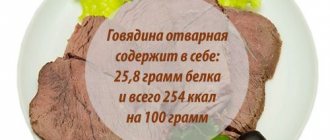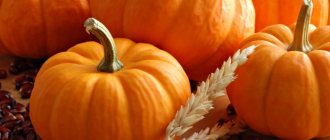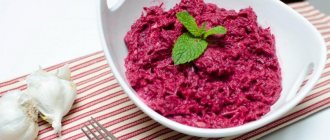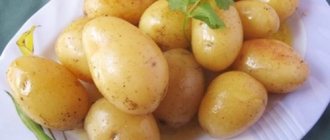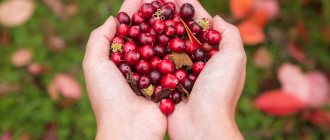Pumpkin is popular in many countries of Europe, Asia, and Central America. In Russia, this vegetable has been the basis of most people’s menus for quite a long time.
Not only is pumpkin in any form very appetizing, but it also carries enormous benefits, and at the same time contains a small amount of calories.
So diet lovers can eat it without fear, without worrying about their figure.
Children's cuisine always uses the healthiest products, containing many substances and elements necessary for the body. That is why it is strongly recommended to include pumpkin dishes in a child’s diet more often.
The calorie content of this vegetable depends on the species and degree of ripening.
100 g of raw pumpkin contains approximately 22-30 kcal.
Why is pumpkin so healthy?
Knowing the value of this food product, many add it raw to salads, and after heat treatment - to soups and main courses. The list of beneficial effects of pumpkin on human health is long.
, but let's take a look at at least some of its points:
- Stabilization of blood pressure, improves the tissue of the walls of blood vessels.
- Removing unnecessary fat from the body, which prevents the accumulation of excess weight.
- Elimination of sand and stones in the urinary system of the body.
- The presence of vitamin E prevents premature cellular aging.
- Vitamin C improves immune function.
- Vitamin D regulates the normal course of metabolic processes and makes bone tissue stronger.
- Remarkable prevention of prostatitis.
- Kidney diseases can be cured with pumpkin juice.
- Makes tooth enamel and gums strong.
- Preventing the development of atherosclerosis.
- Providing a calming effect on the nerves and improving sleep quality.
- Makes the risk of getting tuberculosis and throat cancer low.
- Relieves eye fatigue and improves vision.
- Normalization of the gastrointestinal tract, ridding the body of waste and toxins.
The healing power of pumpkin does not end there, but this list is enough to understand the need to include pumpkin dishes in your diet as often as possible.
I would also like to separately highlight the valuable property of this melon crop - the acceleration of metabolic processes in the body. Thanks to vitamin T, heavy foods are easily digested, harmful substances are removed and fat deposition is blocked.
By eating pumpkin, a person not only does not gain weight, but he also loses the accumulated weight.
and unnecessary.
How is pumpkin good for weight loss?
And more on this topic:
Can pumpkin help you lose extra pounds? Maybe!
Its clear advantage is the low amount of calories and the presence of vitamin T (carnitine), which can significantly speed up metabolic processes and intensively burn fat deposits. The vitamin strengthens muscle mass rather than causing it to sag after weight loss.
The pulp contains 95% water and fiber, which will delay hunger and reduce appetite. Fiber also enhances intestinal transit, prevents fat from being absorbed and cleanses the intestines of toxins.
The plant fibers present in its pulp slow down the absorption of glucose by the body and stabilize blood sugar levels. And when you are on a diet, then stability of sugar levels is necessary, because otherwise an increase in sugar levels will cause a slowdown in weight loss processes.
By eating dishes with pumpkin for two weeks, you can reduce your weight by up to six kilograms, and if you add physical activity, you can lose all eight kilograms.
- Pumpkin cleanses the liver of toxins and reduces cholesterol, restoring metabolic processes.
- Has a diuretic effect. Which is good not only for weight loss, but also for getting rid of swelling and reducing pressure in blood vessels due to excess fluid.
- Pumpkin has a mild laxative effect, thereby speeding up metabolism.
Since the calorie content of pumpkin is very low, the dietary menu based on it can be quite varied.
- Author: Maria Sukhorukikh
Rate this article:
- 5
- 4
- 3
- 2
- 1
(0 votes, average: 0 out of 5)
Share with your friends!
Calorie content of baked and stewed pumpkin
Baking pumpkin in the oven makes it somewhat denser, which makes it higher in calories, but not significantly so.
100 g of baked pumpkin contains 32 kcal.
Even in this form, this vegetable is indicated for dietary nutrition, because its number of calories is almost unchanged.
To slightly change the taste of baked pumpkin, you can cook it with other products, but in this case the calorie content will increase slightly.
Nutritional value of baked pumpkin:
- proteins 1 g;
- fats 0.5 g;
- carbohydrates 6 g.
The energy value of stewed pumpkin is slightly higher than baked pumpkin
. But again, insignificantly, and both of these dishes are absorbed equally well.
There are 37 kcal per 100 g of stewed pumpkin.
Its nutritional value:
- proteins 1.2 g;
- fats 1.25 g;
- carbohydrates 5.5 g.
As we can see, the numbers for these two dishes are almost the same, so it doesn’t really matter what kind of heat treatment the pumpkin will be subjected to - it will bring benefits in any case.
Losing weight with pumpkin is easy!
“How many calories are in pumpkin?” - this question interests those representatives of the fair sex who are accustomed to calculating the energy value of dishes. The calorie content of pumpkin is very low, 3 times less than the calorie content of potatoes, so it is recommended for consumption in cases of metabolic disorders, a tendency to be overweight, and as a means to get rid of extra pounds. Depending on the cooking method, calories per 100 grams of product may vary. The pulp contains about 1% protein, 0.1% fat and 4-5% carbohydrates by weight.
You can eat it raw, boiled, stewed, baked. The lowest calorie content is for raw vegetables, a little more than 20 kcal per 100 g of product. Keep in mind that the sweeter the melon, the higher the calorie content. But you can’t eat much of it raw, except perhaps in the form of a salad, but some other products are usually added to it, and pumpkin increases calories.
Boiled vegetable contains 24 kcal. To prepare the vegetable, cut it into small pieces and boil it in salted water. This is the most useful product for weight loss. To prevent bloating (and this sometimes happens when eating boiled pumpkin), you can add dill or its seeds to the dish.
Baked pumpkin has slightly more calories. This is due to the compaction of the product. However, 27 kcal is also low. To improve the taste, sugar, honey or other ingredients are added to the vegetable. However, the baked “queen of vegetables” will not be low in calories.
You can steam or stew the vegetable. The calorie content of stewed pumpkin will be the same as boiled pumpkin. They also dry it. The dried product has the same number of calories as the raw product.
Pumpkin boiled with sugar
As children, many of us enjoyed a bright orange dessert made from pumpkin boiled in sweet water and sprinkled with sugar. Despite the presence of sugar and the fact that this dish belongs to the category of desserts, there are absolutely no calories in it and it is not prohibited in the diet menu.
Calorie content of 100 g of pumpkin boiled with sugar is 36 kcal.
To prepare this dish, we will need:
- 1 kg pumpkin;
- 1300 ml water;
- 5 tbsp sugar.
Place pieces of pumpkin of approximately the same size, peeled, into a saucepan and cover with cold water, add sugar and put on fire. You can add some spices to improve the taste.
Boil and cook for 10 minutes until the pieces are easily pierced with a fork. Remove the pumpkin to a plate, sprinkle with sugar and leave to cool.
It takes little time and effort to prepare such a dessert, but the benefits and pleasure from consumption are enormous.
How many calories are in steamed pumpkin?
Steamed dishes are dietary and the healthiest.
After all, all the substances and microelements necessary for a person remain intact in such products.
And the calorie content of dishes that have undergone this particular heat treatment is always minimal.
100 g of steamed pumpkin contains 27 kcal.
Whatever cooking method is chosen, be sure to first cut the pumpkin and peel and remove seeds. If the vegetable is tough, it will take longer to cook.
Calorie content and nutritional value of 100 grams of boiled pumpkin
- Calorie content: 19 kcal
- Proteins: 0.6 g
- Fat: 0.2 g
- Carbohydrates: 3.6 g
Pumpkin porridge, known to everyone since childhood, is prepared from a type of pumpkin. Mentions of its use as food can be found in Aztec texts in North America.
This juicy fruit is a natural storehouse of all kinds of vitamins and minerals. It is a source of beta-carotene, vitamins C, E, PP, B1, B2, K. Vitamin T helps in the absorption of heavy foods and in the fight against obesity. Therefore, pumpkin can often be found in dietary menus.
Thanks to the minerals calcium, potassium, iron, copper, cobalt and zinc, it is actively used for medicinal purposes. Pumpkin juice is useful for men to increase potency. Potassium will help strengthen blood vessels and relieve swelling. Fresh pulp or rice, semolina, millet porridge is used for kidney problems. Pumpkin seeds are used to combat worms. In folk medicine, pumpkin pulp was used to treat burns, skin rashes, acne and eczema.
In Rus', this vegetable was highly revered and many simple, tasty dishes were prepared. For food, it is best to choose fruits up to 5 kg. You can use pumpkin to cook jelly, soups, make stews, bake pies, fry pancakes, bake, add to salads and porridges.
For reference: ready-made meals and products.
The vitamin and mineral composition of pumpkin is represented by vitamins PP, K, E, C, B1, B2, B5, B6, B9, A, beta carotene, minerals zinc, selenium, copper, manganese, phosphorus, magnesium, potassium, calcium.
The calorie content of baked pumpkin per 100 grams is 45 kcal. In 100 g of vegetable dish there are 1.2 g of protein, 1.6 g of fat, 6.1 g of carbohydrates.
To prepare baked pumpkin you need the following ingredients:
- 1.25 kg of vegetables;
- 5 tablespoons of sugar;
- 3 tablespoons butter;
- 1 glass of milk.
- the pumpkin is thoroughly washed, cut into halves, and cleared of seeds;
- the washed vegetable, without peeling, is cut into 4 – 7 pieces;
- Place the pieces on a baking sheet and place in an oven preheated to 200°C. Baking time is approximately 20 – 25 minutes;
- The butter is cut into cubes and melted in a water bath. To do this, place a pan of water over high heat, and place a bowl with pieces of butter on top of it;
- the baking sheet with the baked pumpkin is removed from the oven, the baked vegetable is poured with melted butter, sprinkled with sugar and brought to a finished state in the oven at a temperature set to 180 ° C;
- To prevent the pumpkin from burning, you can cover it on top with foil;
- The baked vegetable is served hot or cold. For a richer taste, you can pour cream or milk over the pumpkin.
Stewed and boiled pumpkin - is there a difference?
Boiled and stewed pumpkin have the same calorie content and chemical composition. With these cooking methods, nutrients and taste are preserved.
Which pumpkin is healthier: raw, boiled or stewed?
Pumpkin is equally useful in any form. The difference is that in the raw pulp the chemical composition and coarse fiber are completely preserved. Therefore, this product can be safely consumed by people who do not have problems with the digestive and endocrine systems, receiving maximum health benefits.
Boiled or stewed pumpkin is certainly rich in vitamins and minerals. Gentle heat treatment allows you to preserve the beneficial properties of the vegetable. Cooked pulp is gentler on the intestines and easier to digest. Even diabetics and small children are allowed to eat boiled pumpkin.
Calorie content of millet porridge with pumpkin per 100 grams
The calorie content of millet porridge with pumpkin per 100 grams is 100 kcal. In 100 g of dish there are 2.9 g of protein, 1.7 g of fat, 19.5 g of carbohydrates.
To prepare one 274-gram serving of millet porridge with pumpkin, you need the following ingredients:
- 50 g pumpkin;
- 50 g millet cereal;
- 100 ml water;
- 60 ml milk;
- 1 g salt;
- 13 g sugar.
- cut the pumpkin into cubes, place in a pan filled with water, cook over medium heat for 5 minutes;
- millet porridge is added to the pan, the vegetable and porridge are mixed, simmered over low heat for 12 - 15 minutes;
- Salt, sugar, and milk are added to the mixture.
- The porridge is cooked over low heat for 7 - 9 minutes.
Benefits of pumpkin
The following benefits of pumpkin are known:
- the vegetable is characterized by a high content of pectins, which reduce cholesterol levels and restore the functioning of the pancreas;
- this product is indicated for the prevention of hypertension, colitis, atherosclerosis, nephritis;
- thanks to its antiemetic effect, pumpkin is actively used by pregnant women;
- the bactericidal properties of pumpkin allow it to be used for healing wounds and coughing;
- Numerous studies confirm the effectiveness of pumpkin in preventing cancer;
- pumpkin seeds are actively used in folk remedies for worms;
- the pulp of the vegetable removes waste and toxins from the stomach and intestines, stimulates appetite, and has a diuretic effect;
- pumpkin is rich in potassium, which is necessary for the health of the heart, blood vessels, and the prevention of edema;
- the presence of iron makes pumpkin indispensable for anemia;
- Pumpkin vitamin A is good for vision.
Benefits for various diseases
Boiled pumpkin is recommended to be included in the menu for the following diseases:
- gout;
- atherosclerosis;
- pathologies of the intestines, kidneys, liver, gall bladder;
- constipation;
- diabetes;
- obesity;
- skin lesions (dermatitis, eczema);
- diseases of the heart and blood vessels.
When losing weight
Low calorie content, high fiber and pectin content help you easily lose weight and remove excess water, which delays the weight loss process.
Pumpkin pulp increases intestinal contraction and helps eliminate “bad” cholesterol. Coarse fiber, moving through the digestive tract, cleanses the walls of waste and toxins.
Just replace starchy vegetables with boiled pumpkin during your weight loss period, lose weight easily and without failure.
For men
Zinc in the pulp regulates the production of testosterone, improves the quality of seminal fluid, prevents the development of prostatitis, and eliminates problems with urination.
For women
The vegetable is also useful for females. Due to the high content of carotenoids, pumpkin provides an even tan and improves complexion, helps remove deposits in fat traps (sides, hips, back). During menopause, it prevents the development of complications (cardiac dysfunction, osteochondrosis due to a decrease in estrogen).
Folic acid, calcium and phosphorus support a woman’s body during pregnancy and contribute to the full development of the fetus.
Pumpkin damage
Like other products, pumpkin has a number of contraindications, including consumption of the vegetable should be avoided if:
- gastritis;
- diabetes;
- duodenal ulcer;
- tendency to flatulence;
- for allergic reactions to the product and intolerance to the vegetable.
Pumpkin seeds contain a lot of salicylic acid, which provokes excess weight gain and salt deposition. Overeating pumpkin seeds leads to vomiting and nausea.
Pumpkin is a healthy vegetable that contains all the important nutrients for the body. It is in great demand and is very popular in all countries.
This vegetable crop is used in cooking, for the preparation of baby food, various cosmetics and in folk methods of treatment.
The calorie content of this product depends on the method in which it was prepared:
- Boiled.
The calorie content of boiled pumpkin is approximately 24 kcal per 100 grams. Boiled pumpkin is an excellent substitute for potatoes. Such a replacement of vegetables can make the dish dietary. You need to cook the vegetable in small pieces for about half an hour in water with added salt. After cooking, drain in a colander. The small calories of boiled pumpkin will appeal to people who want to lose weight. - Baked.
Baked pumpkin has a little more calories. After all, a vegetable cooked in the oven becomes slightly denser. The calorie content of such a product will be 27 kcal per 100 grams. This indicator is low, so it can be safely included in the diet. Baked pumpkin has a very strong flavor. To give different flavors, you can cook this vegetable in the oven with other ingredients. Of course, the calorie content of such a dish will increase. But the taste will be more pleasant. - Stewed.
If you steam cook, the calorie content will also be 27 kcal per 100 grams, the same as the dish in the oven. Steamed food is considered the healthiest. It retains all taste and vitamin qualities intact. - Raw.
The calorie content of raw vegetable crops is 20 kcal per 100 grams. Very often this product is used in various salads. Although raw vegetables are healthier than other types, they are much less digestible. - Dried.
This product retains all the beneficial substances in their original form. At the same time, calorie content does not change. It is still 20 kcal per 100 grams.
For any cooking method, the pumpkin should be cut, peeled and all seeds removed. The average preparation time is 20-30 minutes, excluding boiling. Cook the vegetable for no more than 15 minutes. If the product is stale, it is recommended to increase the cooking time slightly.
You can use it in salads and instead of a side dish. Excellent dishes are obtained stuffed. You can bake the whole vegetable in the oven. The filling can be simple porridge or vegetable stew. It will take approximately 45 minutes to cook completely.
In principle, it goes well with any food, but the most delicious dishes are obtained in combination with other vegetables, various herbs and starchy foods. Among the spices, you should choose thyme, saffron, garlic, rosemary, oriental spices, black pepper, cumin and cinnamon.
Canned
The term “canning” means any method of technical processing of food products aimed at inhibiting pathogenic microorganisms, as well as some other methods of extending shelf life. Of the variety of canning options for harvesting this berry, the most often used is pickling and making jam, as well as freezing and drying.
Frozen
Pumpkins are frozen in several ways, depending on the purpose of further use. To preserve maximum beneficial properties, it is recommended to freeze it raw, but if desired, you can first steam or bake it in order to store the ready-to-eat product in the freezer.
When frozen raw, the vegetable is peeled, removed from the skin, internal fibers and seeds, and then cut into pieces or grated. To obtain the puree, the pumpkin is first baked with its skin and then the inside is scraped out with a metal spoon. You can also boil the peeled pieces in water or steam and then grind them in a blender.
When freezing in pieces, the prepared raw materials are laid out on a flat surface in one layer at some distance from each other so that the cubes do not freeze together. After 2–3 hours, they are packaged in portioned containers for further storage (plastic bags or plastic containers).
The puree or grated pulp is placed directly into the container. Typically, disposable cups, silicone molds, bags or any other suitable containers are used for this. Pumpkin frozen at a temperature of –18°C and below retains its taste and beneficial properties in the freezer for up to 10-12 months.
Dried
Drying is the most reliable way to preserve vitamins, minerals and other valuable substances contained in raw fruits. But due to the almost complete removal of water, which contains more than 90% of pumpkin pulp, their concentration increases significantly and, in accordance with this, the calorie content of the pumpkin rises.
Compared to raw pulp, the number of calories in dried pulp almost doubles – up to 41–68 per 100 grams. But even this parameter is considered minimal for this category of products, especially when compared with dried fruits, for which dried pumpkin is more similar in sweetness than dried vegetables.
Since the biochemical composition of the dried berry becomes much more concentrated, its beneficial effect on human health is more pronounced. With regular use, the beneficial properties of this product allow you to obtain the following results:
- the functioning of internal organs and systems is normalized;
- metabolic processes are activated;
- the removal of waste and toxins is accelerated;
- increases strength and endurance during physical activity;
- the functioning of the digestive system is improved;
- mental abilities, concentration and memory improve;
- the fullness of vision is preserved, eye health is strengthened;
- overall immune defense is enhanced.
It’s easy to dry pumpkin yourself at home. Several methods are used for this purpose:
- natural drying in the open air;
- the use of an electric dryer, which ensures that the required temperature is maintained to preserve the maximum of useful substances;
- using an oven as an alternative to an electric dryer.
The easiest and most convenient way is to dry the slices in a special electric dryer at a constant temperature of 55ºC. Drying in the oven is much faster than in the open air, but not as good as in an electric dryer. To preserve the bright orange color, before drying it is recommended to blanch the cut pieces by immersing them in boiling water for 2 minutes and then immediately in cold water.
If desired, the water can be sweetened or salted a little. It should be borne in mind that the blanching process itself will lead to the loss of some of the valuable substances, and the use of sugar will increase the energy value of the final product. Therefore, the most useful and dietary option would be drying in a natural way without any pre-treatment.
There is also another option for drying the orange pulp - in the form of thin sheets, which are then used in the form of chips or crushed into powder. To do this, the fruits are cut into 2–4 parts, cleaned of seeds and internal fibers, and then baked in an oven preheated to 170ºC for 20–40 minutes, depending on the size of the pieces.
The pulp extracted from the peel is laid out in a thin layer on an electric dryer tray or oven tray and dried until brittle orange sheets are obtained. They are broken into pieces to make excellent natural chips, or crushed into powder using a coffee grinder, which is later added to cereals, desserts, baked goods and other culinary products.
We invite you to familiarize yourself with the recipe for Carp in the oven
